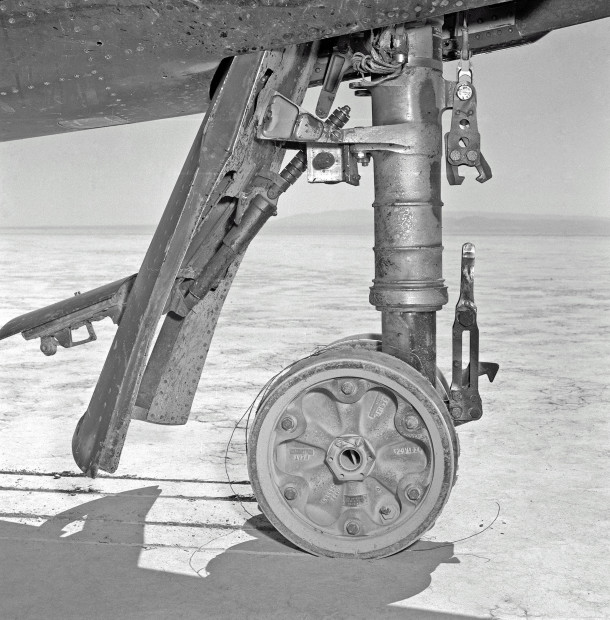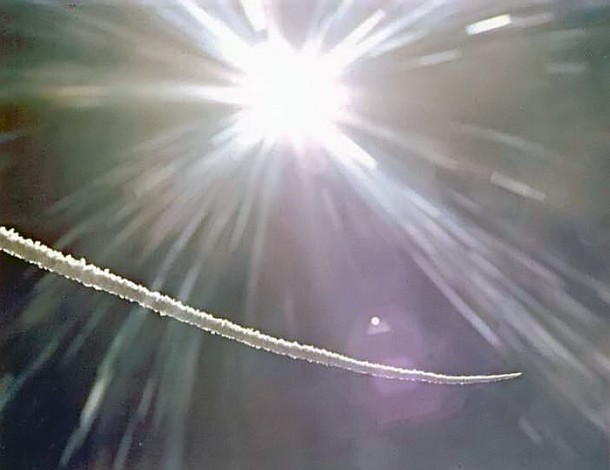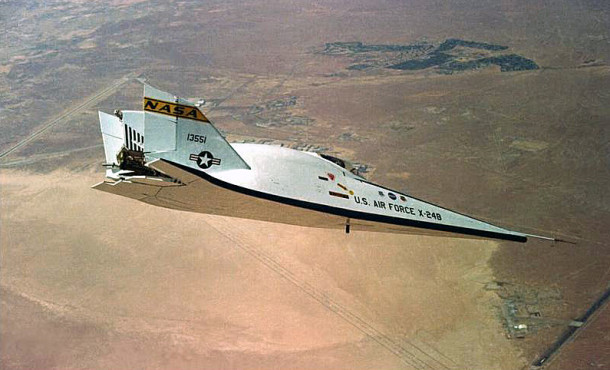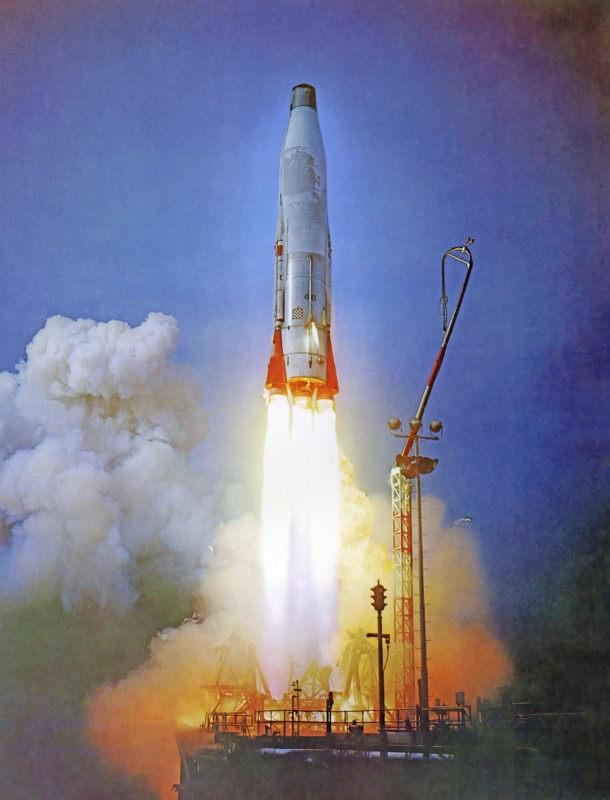
Fifty-one years ago this month, the North American X-15 hit a speed of 3,590 mph (Mach 5.23) in a flight that reached an altitude of 103,300 feet. While decelerating through Mach 4.2, the nose gear of the aircraft unexpectedly deployed in flight.
The 114th powered flight of the legendary X-15 Program took place on Friday, 14 August 1964. USAF Major Robert A. Rushworth was at the controls of X-15 Ship No. 2 (S/N 56-6671). The mission would be Rushworth’s 22nd flight in the famed hypersonic aircraft.
X-15 drop from the NB-52A (S/N 52-0003) launch aircraft took place over Delamar Dry Lake, Nevada. Seconds later, Rushworth called for 100% power from the X-15’s XLR-99 liquid-fueled rocket engine as he pulled into a steep climb. He subsequently pushed-over and then leveled-off at 103,300 feet.
XLR-99 burnout occurred 80.3 seconds after ignition. At this juncture, the X-15 was traveling at 3,590 mph; better than 5 times the speed of sound. Following rocket motor burnout, the aircraft slowed and began to lose altitude under the influence of weight and aerodynamic drag.
As the Mach meter needle passed through Mach 4.2, Rushworth heard a loud bang from the airframe. The aircraft became hard to control as it gyrated in pitch, yaw and roll. Rushworth was equal to the moment and brought his troubled steed under control. However, the aircraft had an uncommanded sideslip and Rushworth had to use left aileron to hold the wings level.
Gathering his wits, Rushworth realized that the loud bang he heard was very similar to that which occurred when the nose gear was deployed in the landing pattern. Unaccountably, the X-15 nose gear had deployed in supersonic flight. An unsettling confirmation of Rushworth’s hypothesis came when the pilot spotted smoke, quite a bit of it, in the X-15 cockpit.
As Rushworth neared Edwards Air Force Base, chase aircraft caught up with him and confirmed that the nose gear was indeed down and locked. Further, the tires were so scorched from aerodynamic heating that they probably would disintegrate during touchdown on Rogers Dry Lake. They verily did.
Despite his tireless nose gear, Rushworth was able to control the rollout of his aircraft fairly well on the playa silt. He brought the X-15 to a stop and deplaned. Man and machine had survived to fly another day.
Post-flight analysis revealed that expansion of the X-15 fuselage due to aerodynamic heating was greater than expected. The nose gear door bowed or deformed outward more than anticipated as well. Together, these two anomalies caused the gear uplock hook to bend and release the nose gear. Fixes were subsequently made to Ship No. 2 to prevent a recurrence of the nose gear door deployment anomaly.
Rushworth next flew X-15 Ship No. 2 on Tuesday, 29 September 1964. He reached a maximum speed of 3,542 mph (Mach 5.2) at 97,800 feet. The nose gear door remained locked. However, while decelerating through Mach 4.5, Rushworth heard a bang that was less intense than the previous flight. This time, thermal stresses caused the nose gear door air scoop to deploy in flight. While the aircraft handled poorly, Rushworth managed to get it and himself back on the ground in one piece.
Following another redesign effort, Rushworth took to the air in X-15 Ship No. 2 on Thursday, 17 February 1965. He hit 3,539 mph (Mach 5.27) at 95,100 feet. On this occasion, both the nose gear door and nose gear door scoop remained in place. Unfortunately, the right main landing skid deployed at Mach 4.3 and 85,000 feet.
Thermal stresses were once again the culprit. Despite degraded handling qualities with the landing skid deployed, the valiant Rushworth safely landed the X-15. Upon deplaning, he is reported to have kicked the aircraft in a show of disgust and frustration. Unprofessional maybe, but certainly understandable.
Yet another redesign effort followed in the aftermath of the unexpected main landing skid deployment. This was the third consecutive mission for X-15 Ship No. 2 and Rushworth to experience a thermally-induced landing gear or landing skid deployment anomaly. Happily, subsequent flights of the subject aircraft were free of such vexing issues.

Fifty-two years ago this week, NASA chief research pilot Joseph A. Walker flew X-15 Ship No. 3 (S/N 56-6672) to an altitude of 354,200 feet. This flight would mark the highest altitude ever achieved by the famed hypersonic research vehicle. The date was Thursday, 22 August 1963.
Carried aloft by NASA’s NB-52A (S/N 52-0003) mothership, Walker’s X-15 was launched over Smith Ranch Dry Lake, Nevada at 17:05:42 UTC. Following drop at around 45,000 feet and Mach 0.82, Walker ignited the X-15’s small, but mighty XLR-99 rocket engine and pulled into a steep vertical climb.
The XLR-99 was run at 100 percent power for 85.8 seconds with burnout occurring around 176,000 feet on the way uphill. Maximum velocity achieved was 3,794 miles per hour which tranlates to Mach 5.58 at the burnout altitude. Following burnout, Walker’s X-15 gained an additional 178,200 feet in altitude as it coasted to apogee.
Joe Walker went over the top at 354,200 feet (67 miles). Although he didn’t have much time for sight-seeing, the Earth’s curvature was strikingly obvious to the pilot as he started downhill from his lofty perch. Walker subsequently endured a hefty 5-g’s of eyeballs-in normal acceleration during the backside dive pull-out. The aircraft was brought to a wings-level attitude at 70,000 feet. Shortly after, Walker greased the landing on Rogers Dry Lake at Edwards Air Force Base, California.
The X-15 maximum altitude flight lasted 11 minutes and 8 seconds from drop to nose wheel stop. In that time, Walker and X-15 Ship 3 covered 305 miles in ground range. The mission was Ship No. 3’s 22nd flight and the 91st of the X-15 Program.
For Joseph Albert Walker, the 22nd of August 1963 marked his 25th and last flight in an X-15 cockpit. The mission qualified him for Astronaut Wings since he had exceeded the 328,000 foot (100 km) FAI/NASA standard set for such a distinction. Ironically, the historic record indicates that Joe Walker never officially received Astronaut Wings for this flight in which the X-15 design altitude was exceeded by over 100,000 feet.

Forty years ago this month, the USAF/NASA/Martin X-24B became the first lifting body to make an unpowered precision landing on a concrete runway. The feat was pivotal to convincing NASA officials that landing the Space Shuttle Orbiter in an unpowered state was operationally feasible.
Early Space Shuttle Orbiter operational concepts featured the use of a pair of turbojets to provide a powered landing capability. These airbreathing engeines were to be internally stowed just below the Orbital Maneuvering System (OMS) pods. The turbojets would be deployed and started once the Orbiter had decelerated to high subsonic flight speeds.
While airbreathing propulsion would give the Orbiter a loiter and go-around capability, the drawbacks were significant. Jet fuel would have to be carried into and out of earth orbit. The weight of this fuel and the turbojets would severely penalize Orbiter payload capability. Further, the system would increase both the complexity of and cost to Shuttle operations.
As the Shuttle Program grappled with the development of a powered landing capability for the Orbiter, the NASA DFRC flight test community made what appeared to be a rather bold claim. The Orbiter could simply glide all the way to touchdown and land deadstick. After all, X-planes had been doing so safely and without incident since the late 1940’s.
A leading proponent of unpowered Shuttle landings was NASA DFRC test pilot John Manke. He was convinced that the Orbiter could routinely and safely conduct unpowered precision landings on a concrete runway. If true, the Orbiter could land anywhere a 15,000-foot concrete runway was located.
Manke proposed that the X-24B (S/N 66-13551) lifting body be employed to conduct unpowered precision landings on Runway 04/22 at Edwards Air Force Base. He and fellow test pilot USAF Lt. Col. Michael V. Love practiced low lift-to-drag precision landings using F-104 and T-38 aircraft in preparation for the demonstrations.
On Tuesday, 05 August 1975, John Manke successfully made the first-ever unpowered precision landing of an aircraft on a concrete runway. The X-24B main gear touched-down exactly at the aimpoint situated 5,000 feet down Runway 04/22. On Wednesday, 20 August 1975, Mike Love duplicated the feat.
Following the successful unpowered precision landings with the X-24B lifting body, John Manke was quoted as saying: “We now know that concrete runway landings are operationally feasible and that touchdown accuracies of ±500 feet can be expected.” NASA Space Shuttle Program management concurred and officially adopted the unpowered precision landing concept.
History records that thirty-one years of Orbiter flight operations confirmed the wisdom of that long-ago decision.

Fifty-seven years ago this week, an Atlas B flew 2,500 miles down the Eastern Test Range in a key developmental test of America’s first Intercontinental Ballistic Missile (ICBM). Among other historic achievements, the test marked the first successful flight of the innovative stage-and-a-half missile.
The infamous Cold War between the United States and the Soviet Union was marked by the specter of nuclear confrontation. Each side developed a family of launch vehicles that could deliver nuclear ordnance to the homeland of the other. The type of launch vehicle employed is known as an Intercontinental Ballistic Missile (ICBM).
An ICBM flies a long, arcing (sub-orbital) trajectory to the target. This flight path is parabolic in shape and thousands of miles in range. The maximum altitude point (apogee) is about mid-way to the target and is located hundreds of miles above the surface of the Earth. An ICBM can reach any point on the globe within 30 minutes of launch.
The first ICBM developed by the United States was the Atlas missile. The origins of this program date back to late 1945 when the United States Army requested proposals from the aerospace industry for novel long-range missile concepts. Consolidated-Vultee Aircraft (Convair) caught the Army’s eye with a missile design that ultimately became the Atlas.
The Atlas was innovative from a number of standpoints. Perhaps most novel was the use of very thin stainless steel tankage in an effort to provide the Atlas with an extremely lightweight structure. However, the tank was so thin that a screwdriver could easily puncture its walls. Moreover, the tank would collapse even under its own weight. Nitrogen pressurization was employed to obtain the necessary structural rigidity.
Another Atlas innovation involved the use of the so-called stage-and-a-half or parallel staging propulsion concept. This system was comprised of a pair of outboard boosters (Stage 0) and a single sustainer core (Stage 1). These engines burned a LOX/kerosene propellant mix and were ignited at launch. Stage 0 was jettisoned after 135 seconds of flight. The sustainer continued to fire an additional 95 seconds.
Atlas A was first flown in June of 1957. The type operated the booster engines only and carried a mass simulator warhead. Only three (3) of its eight (8) developmental flight tests were considered successful. The type achieved a maximum range of 600 nm during its third flight which occurred on Tuesday, 17 December 1957.
Atlas B was the first Atlas test vehicle to operate both the booster and sustainer rocket engines. The vehicle measured 85 feet in length and had a diameter of 10 feet. Lift-off weight was slightly over 244,000 pounds. Its XLR89-5 booster engines and XLR105-5 sustainer engine generated 341,130 and 81,655 pounds of vacuum thrust, respectively.
Atlas B test vehicles flew ten (10) times and enjoyed seven (7) successful flight tests. The first launch (Atlas B, Serial No. 3B) occurred on Friday, 19 July 1958 and was not successful. Atlas B, Serial No. 4B lifted-off from Cape Canaveral’s LC-13 at 22:16 UTC on Saturday, 02 August 1958. This test was entirely successful as the missile reached an apogee of 560 miles and traveled 2,500 miles downrange.
In the years that followed, other Atlas variants were developed including the Atlas C, D, E, F, G and H. Atlas C was the first pre-production version of the Atlas Program. Atlas D was the first operational version of the Atlas ICBM. Atlas E and Atlas F missiles were the first ICBM’s stored in underground silos and raised to ground level for launch. Atlas G and H launched numerous space exploration payloads.
Ironically, the Atlas did not serve long in its primary role as an ICBM. The type was quickly eclipsed by more capable launch vehicles such as the Titan II. However, the Atlas would be used to great effect as a launch vehicle for a wide variety of satellites and scientific spacecraft. The Atlas was ultimately man-rated as a booster. It was used to successfully orbit Mercury astronauts during four (4) Mercury missions flown in 1962 and 1963.
The Atlas has continued to evolve as a commercial launch platform to the current day. The Atlas I was introduced in July of 1990. It was followed by the Atlas II and Atlas III in 1991 and 2000, respectively. The Atlas V is the most recent Atlas variant and first flew in 2002. Significantly, the Atlas is the longest running launch vehicle program in the history of American spaceflight.




